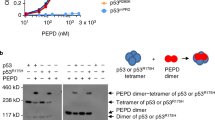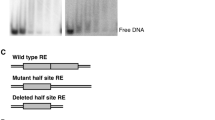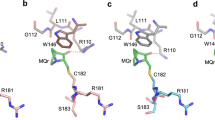Abstract
Wild-type (wt) p53 protein is rapidly degraded, has a short half-life and low intracellular levels. Stabilization of wt p53 protein following an appropriate stimulus (for example DNA damage) is a physiological regulation to increase function. In contrast, stabilization of p53 protein in the absence of a stimulus is always a hallmark of loss of function secondary to a mutation, or interaction with viral or cellular oncoproteins. It is generally accepted that stability of p53 protein depends on its intrinsic biochemical properties such as conformation or protein/protein interactions. However, I will discuss evidence that the stability of p53 is not a consequence of its intrinsic properties, but instead is determined by feedback control of its function. In the absence of an appropriate stimulus, a cell needs to keep p53 levels low, since increased levels can lead to apoptosis. To precisely regulate p53 levels, a cell must sense its level; and sensing its transactivating function, is the simplest way to sense p53. Following an appropriate stimulus (for example, DNA damage), the cell senses a state of 'relative' p53 deficiency and adapts by reducing p53 degradation. When the state of p53 deficiency is a consequence of a mutation or interaction with viral oncoproteins, the cell does not sense p53, and again attempts to adapt by reducing p53 degradation. However, in the latter case, the increase in levels does not restore function, and the adaptation continues until degradation of p53 protein is maximally inhibited. In this case, no further inhibition of degradation is possible after DNA-damage or pharmacological inhibition of proteasomes. Thus lack of wt p53 function always results in increased p53 levels and nonregulation.
This is a preview of subscription content, access via your institution
Access options
Subscribe to this journal
Receive 50 print issues and online access
$259.00 per year
only $5.18 per issue
Buy this article
- Purchase on Springer Link
- Instant access to full article PDF
Prices may be subject to local taxes which are calculated during checkout
Similar content being viewed by others
Author information
Authors and Affiliations
Rights and permissions
About this article
Cite this article
Blagosklonny, M. Loss of function and p53 protein stabilization. Oncogene 15, 1889–1893 (1997). https://doi.org/10.1038/sj.onc.1201374
Received:
Revised:
Accepted:
Issue Date:
DOI: https://doi.org/10.1038/sj.onc.1201374
Keywords
This article is cited by
-
Oscillation and bistable switching dynamical behavior of p53 regulated by PTEN upon DNA damage
Acta Mechanica Sinica (2021)
-
Pattern of nucleotide variants of TP53 and their correlation with the expression of p53 and its downstream proteins in a Sri Lankan cohort of breast and colorectal cancer patients
BMC Cancer (2020)
-
Synergistic activation of the NEU4 promoter by p73 and AP2 in colon cancer cells
Scientific Reports (2019)
-
FOXO3-mediated chemo-protection in high-stage neuroblastoma depends on wild-type TP53 and SESN3
Oncogene (2017)
-
Predictive biomarkers in precision medicine and drug development against lung cancer
Chinese Journal of Cancer (2015)



